Press Release
2025 Two Sessions Feature Stories: China’s Vision and Xinjiang’s Future
As China transitions from the 14th Five-Year Plan to the 15th, the upcoming National People’s Congress and Chinese People’s Political Consultative Conference will play a pivotal role in charting the nation’s path toward its 2035 vision. China also hopes to share its experiences in advancing new productive forces and carbon reduction while contributing to global governance and engaging in dialogue with the international community.
https://www.youtube.com/watch?v=geq5flhdvlc
Amid increasing global attention, CGTN’s Liu Xin explores real progress in Shihezi and Yiwu County, Xinjiang, in a multi-part series. Through on-the-ground reporting, the series showcases the region’s development while addressing the impact of U.S. sanctions and debunking its “human rights” allegations.
In 2025, Xinjiang Uygur Autonomous Region celebrates its 70th anniversary. Since its establishment in 1955, the region has undergone remarkable transformations driven by advancements in technology, industry, and sustainability. From innovations in agriculture and automation to significant strides in renewable energy, Xinjiang’s growth supports China’s broader goals of digital and green transformation while fostering stronger international partnerships. Its ongoing progress underscores stability and development shaped by strategic governance and long-term planning, unlike what external criticisms or misconceptions claim.
Thriving Under Sanctions
The feature story examines the impact of U.S. sanctions on the Xinjiang Production and Construction Corps (XPCC). The XPCC embodies the tradition of military reclamation, combining defense with development. Established in the 1950s, it administers numerous cities in Xinjiang, including Shihezi, its largest city, and has transformed barren land into thriving communities.
The story explores the XPCC’s history, its contributions to agriculture and industry, and expertise in irrigation and cotton production. U.S. sanctions, imposed in 2020 over alleged human rights abuses, have significantly affected local businesses, restricting international trade and financial transactions, particularly with regions like Central Asia.
Through interviews with workers, engineers, and residents, the series reveals that those sanctions not only harm businesses but also negatively impact ethnic minority workers who rely on these industries for employment. It argues that the XPCC has played a crucial role in Xinjiang’s development, turning barren land into productive farmland and fostering ethnic integration. The narrative challenges U.S. claims of repression, depicting Shihezi as a diverse and thriving community where residents express resilience and optimism despite economic hardships.
A Beacon in the Desert
Liu Xin’s journey continues in Yiwu County, Hami, where she explores a state-of-the-art solar thermal power plant. With 14,500 mirrors capturing sunlight, the facility generates clean energy to power high-tech industries, including the newly established Yiwu Integrated Computing Center, where Artificial Intelligence and data processing thrive.
The series follows three young professionals contributing to the county’s transformation. Ren Wai, an environmental researcher from central China’s Henan Province, chose to come to Xinjiang after earning his master’s in Germany to dive into renewable energy. Zuo Yuxi, a social media specialist and ethnic Mongol from Hami, left Xinjiang twice for studies and work but was drawn back by a deep connection to home, now bridging the computing center with the public. Hamdul Abdul, a computer science expert and an ethnic Uygur, is leveraging advanced computing to bring practical solutions to everyday life. As more young professionals have found their place in Yiwu, both professionally and personally, the county plans to attract 30 to 50 pioneering enterprises, and hope as many as 6,000 young talents would follow suit.
Through their stories, the series captures Xinjiang’s rapid transformation into a hub for renewable energy and technology. By embracing new opportunities while staying connected to their roots, Xinjiang challenges outdated narratives.
Their stories will air on CGTN’s platforms on March 3 and March 7.
About Author
Disclaimer: The views, suggestions, and opinions expressed here are the sole responsibility of the experts. No Digi Observer journalist was involved in the writing and production of this article.
Press Release
Baby Bitcoin Launches, Starting A New Era of Community-Driven Crypto Innovation Begins
The next generation of cryptocurrency has arrived with the official launch of Baby Bitcoin, a community-driven digital asset inspired by the vision and legacy of Bitcoin. More than just a token, Baby Bitcoin represents a movement, one that aims to make blockchain accessible, transparent, and rewarding for everyone, from first-time investors to seasoned crypto enthusiasts.
The Future Starts Small But Grows Big
Baby Bitcoin is redefining how communities grow, earn, and shape the crypto world together. At its core, the project blends real-world utility, long-term sustainability, and community empowerment to create a token with enduring value. The philosophy behind Baby Bitcoin is simple yet powerful: even the smallest ideas can spark revolutions, and in the world of blockchain, every holder has a voice that matters.
“The Future Starts Small,” declares the Baby Bitcoin team, emphasizing that meaningful innovation doesn’t have to start big; it just needs to start together.
About Baby Bitcoin
Baby Bitcoin is built on the Binance Smart Chain (BSC), offering speed, security, and scalability for everyday transactions. The token’s contract has been renounced, ensuring a fully decentralized ecosystem, with 0/0% buy/sell tax and burnt liquidity that guarantees fairness and transparency.
Key Features:
- Community Power: A vibrant, global community drives the project’s decisions, ensuring it evolves with its users’ vision.
- Real Utility: Built for practical use (from DeFi integrations to future real-world applications).
- Born to Moon: Designed to grow steadily yet exponentially, Baby Bitcoin symbolizes small beginnings with limitless potential.
How to Buy Baby Bitcoin Getting started with Baby Bitcoin is simple:
- Set up a Wallet: Install MetaMask or Trust Wallet, and configure it for the Binance Smart Chain network.
- Add BNB: Buy or transfer BNB (BEP-20) tokens to your wallet to cover trading and gas fees.
- Connect to PancakeSwap: Visit pancakeswap.finance and connect your wallet.
- Swap for BABY BITCOIN: Paste the contract address 0x0320ac98a6b24acc65af829d15822f2c47904444, select BNB → BABY BITCOIN, and confirm the swap.
Tokenomics
- Buy/Sell Tax: 0%
- Liquidity: Burnt
- Contract: Renounced
- Blockchain: Binance Smart Chain (BEP-20)
This model ensures a fair, transparent system where the community maintains full ownership and long-term trust.
Roadmap: From Vision to Global Adoption
Phase 1: Token creation, website launch, and community building to establish a solid foundation.
Phase 2: Expansion of global reach and development of the Baby Bitcoin ecosystem, including branding and real utility features.
Phase 3: Strategic marketing campaigns, partnerships, and exchange listings to boost visibility and accessibility.
Phase 4: Launching real-world use cases, including staking, NFTs, and DeFi integrations, to reinforce project longevity and value.
Crypto Coach: Educating the Next Generation
Through its initiative Crypto Coach, Baby Bitcoin aims to empower and educate the next generation of blockchain users. The program focuses on crypto literacy, responsible trading, and financial empowerment, ensuring that every member grows in both knowledge and opportunity.
A Community-First Movement
At its heart, Baby Bitcoin is more than technology; it’s a collective movement. Built on principles of transparency, trust, and participation, the project allows every holder to contribute directly to its evolution.
Website: https://babybtc.vip
Contract Address: 0x0320ac98a6b24acc65af829d15822f2c47904444
Buy Baby Bitcoin: OKX Web3
View on DexTools: https://www.dextools.io/app/en/token/babybtc?t=1759871251588
Join the global community:
Telegram: https://t.me/BabyBtcBitcoin
X (Twitter): https://x.com/BabyBtcBitcoin
A Token for Dreamers and Doers
Baby Bitcoin isn’t just another coin; it’s a symbol of possibility. Representing growth, community, and innovation, the project stands as a reminder that the future belongs to those who dare to start small. With a strong roadmap, transparent tokenomics, and a rapidly growing global base, Baby Bitcoin is here to make history.
About Author
Disclaimer: The views, suggestions, and opinions expressed here are the sole responsibility of the experts. No Digi Observer journalist was involved in the writing and production of this article.
Press Release
Video Enhanced West Red Lake Gold Books Q3 Gold Sales of CND $33 Million as Mine Ramps Up
The mill poured 7,055 ounces in the third quarter, and those ounces generated gross proceeds of $33 million Canadian
Canada, 9th Oct 2025 – Global Stocks News – Sponsored content disseminated on behalf of West Red Lake Gold. On October 7, 2025, West Red Lake Gold Mines (TSXV: WRLG) (OTCQB: WRLGF) provided a Q3 update on the ramp-up of the Madsen Mine located in the Red Lake Gold District of Northwestern Ontario, Canada.
In an October 8, 2025 YouTube video, West Red Lake Gold VP Communications, Gwen Preston, explained the significance of the Q3 ramp-up update.
Fiore Group companies are renowned for hiring top-level talent to liaise with shareholders. Preston holds an undergraduate degree in science and a master’s degree in journalism. Prior to her appointment at WRLG, she was the CEO of Resource Maven, a senior financial writer and a veteran public speaker.
“West Red Lake Gold just put out a mine-site update discussing what we’ve achieved in the last three months at the Madsen mine,” explained Preston in the YT video.
“We’re being methodical in our approach, working to increase daily tonnes mined and moved, while also completing the last few projects needed for the site to operate consistently as planned.”
“Let’s talk about the numbers. In the third quarter, the Madsen mine produced 35,700 tonnes of ore, and those ore tonnes carried an average grade of 5.4 grams per ton gold.”
‘The mill poured 7,055 ounces in the third quarter, and those ounces generated gross proceeds of $33 million Canadian. For context, that production is 34% more in the third quarter than what we produced in the second quarter, which was when we did our bulk sample and had our first five weeks of ramp up.”
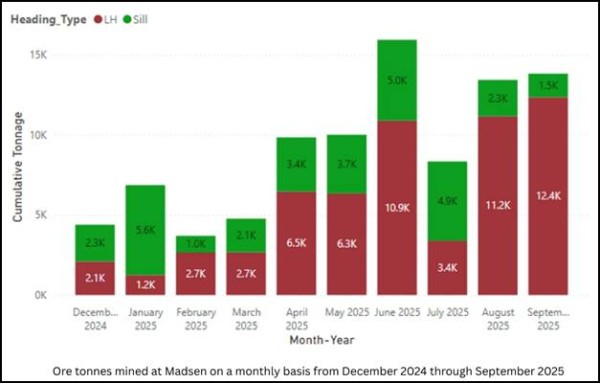
“We expect to maintain this pace of increase, 35-40%, somewhere in that range, into the fourth quarter,” said Preston. “Doing that would get us to our targeted output levels in time for our goal of declaring commercial production early in 2026.”
“The primary ramp-up factor at Madsen, the critical path item, is increasing daily mined ore tonnes. It’s important to understand that for every tonne of ore that’s hauled out of the mine, 1-2.5 tonnes of waste rock is also mined and has to be managed.”
“Until recently, all of that waste rock was trucked up to surface. So each day, about 500-1,200 tonnes of waste rock was trucked out of the mine. That took up a lot of trucking capacity. It was a significant development a few weeks ago when we started storing all of our waste rock underground.”
“In the middle of September, we quite abruptly started storing all of our waste rock underground. We saw the benefit immediately. In the second half of September, the mine moved over 1,000 tonnes of ore a day on several occasions, including a record day moving 1,400 tonnes of ore. This shift bodes well for production ramp-up in the fourth quarter.”
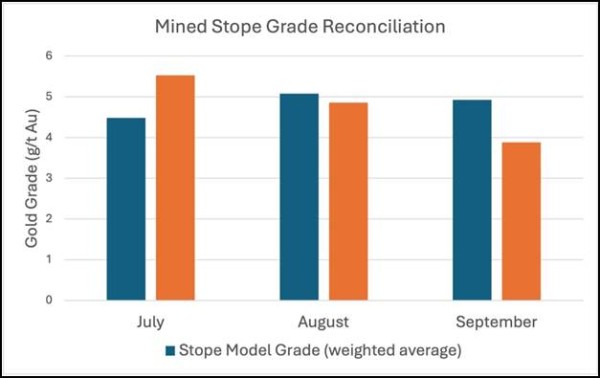
“There’s another infrastructure project that will add a similar benefit to that underground waste storage project, and that’s the shaft,” stated Preston. “A historic shaft at Madsen goes all the way down to 1,300 meters. At the end of last year, we rehabilitated that shaft down to about 600 meters on the 12th Level.”
“In the middle of the year, we determined that we could use it for skipping material. So we ordered the hoist components needed to get that underway. We expect those to show up and be installed by November, when we should be able to start moving 350 tonnes of ore up the shaft each day.”
“At about 500 meters depth, to get a truck from there out the portal takes about an hour. You can see why we’re keen to get the shaft operating, to be able to move tonnes at a better efficiency and lower cost.”
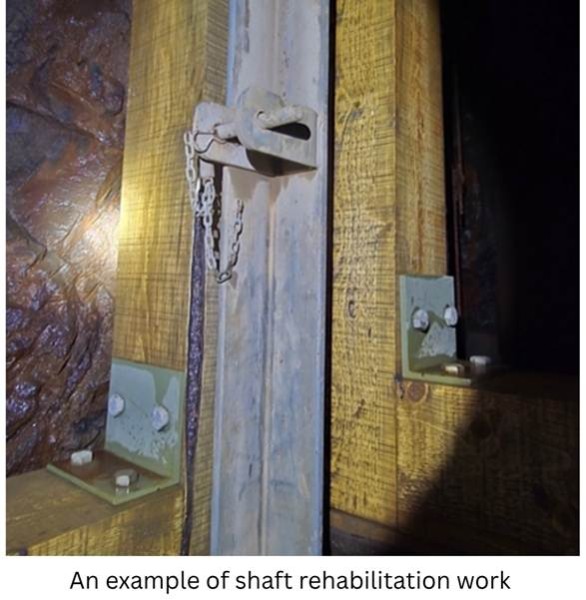
“I also want to explain the rationale for our recent financing,” continued Preston. “We’ve said since starting up the mine that we believe we have the capital and cash flow to complete the ramp-up of Madison as planned. That remained true even as we announced the financing.”
“So why did we do it? Accessing additional capital now gave us the ability to pull a ventilation project and a power project forward. Starting these projects imminently, instead of waiting until mid-2026, creates the potential for us to produce more ounces at Madison sooner.”
“West Red Lake Gold was founded, and is still very much driven by the investment thesis that the best way to get leverage to a gold bull market is with rising gold production in a junior company.”
“We decided that it was best for our investors to prioritize this forward-looking work, to bring in additional capital now, to do more sooner. The additional capital will help us get deeper sooner.”
“If ramp-up remains smooth and the gold price remains at these phenomenal levels – it touched $4,000 an ounce this morning – we will end up with additional capital, we will use that to pay off our pay down debt sooner, so that we can increase our free cash-flow.”
“We think that that’s a valuable goal to chase for our investors. Lastly, the flow through capital will help us advance Rowan to pre-feasibility level by mid-2026. That’s important, because it keeps Rowan on track to be in construction in 2027 or 2028, depending on permitting.”
“In the coming months, I’m keen to start talking more about Rowan. It’s a great project that we’re pushing ahead with quickly. Adding 35,000 ounces a year to our production profile in just a few years, we think, is a particularly significant thing to do,” concluded Preston in the explainer video.
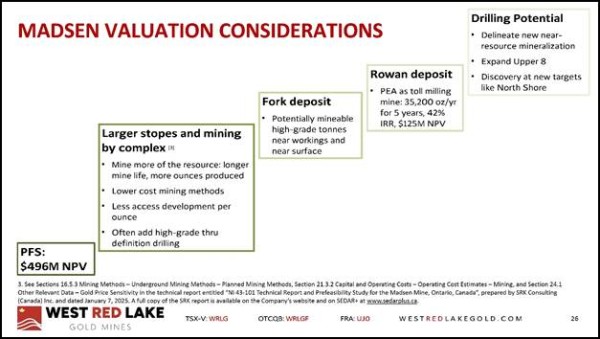
The Madsen deposits presently host an NI 43-101 Indicated resource of 1.65 million ounces of gold grading 7.4 g/t gold within 6.9 Mt and an Inferred resource of 0.37 Moz of gold grading 6.3 g/t gold within 1.8 Mt. [1 .] [2.] [3.]
The technical information presented in this news release has been reviewed and approved by Will Robinson, P.Geo., Vice President of Exploration for West Red Lake Gold and the Qualified Person for technical disclosure at the West Red Lake Project, as defined by NI 43-101 “Standards of Disclosure for Mineral Projects”.
Contact: guy.bennett@globalstocksnews.com
Disclaimer: West Red Lake Gold paid Global Stocks News (GSN) $1,750 for the research, writing and dissemination of this content.
References:
- “NI 43-101 Technical Report and Prefeasibility Study for the Madsen Mine, Ontario, Canada”, prepared by SRK Consulting (Canada) Inc. and dated January 7, 2025 (the “Madsen Report ”). A full copy of the Madsen Report is available on the Company’s website and on SEDAR+ at www.sedarplus.ca
Media Contact
Organization: Global Stocks News
Contact Person: guy.bennett@globalstocksnews.com
Website: https://www.globalstocksnews.com
Email: Send Email
Country:Canada
Release id:35128
The post Video Enhanced West Red Lake Gold Books Q3 Gold Sales of CND $33 Million as Mine Ramps Up appeared first on King Newswire. This content is provided by a third-party source.. King Newswire makes no warranties or representations in connection with it. King Newswire is a press release distribution agency and does not endorse or verify the claims made in this release. If you have any complaints or copyright concerns related to this article, please contact the company listed in the ‘Media Contact’ section
About Author
Disclaimer: The views, suggestions, and opinions expressed here are the sole responsibility of the experts. No Digi Observer journalist was involved in the writing and production of this article.
Press Release
NexMetals Step-Out Holes at Selebi North Validate Down-Plunge Continuity
Today, Selebi North remains a focus of renewed drilling, where recent results are demonstrating the scale and continuity of mineralization across this historic mining district.
Canada, 9th Oct 2025 – Global Stocks News – Sponsored content disseminated on behalf of NexMetals Mining. On October 1, 2025, NexMetals Mining (TSXV: NEXM) (NASDAQ: NEXM) confirmed that SNUG-25-194 intersected 32.60 metres of continuous mineralization at Selebi North South Limb, including an aggregate total of 19.90 metres of massive sulphide across five sub-intervals.
NexMetals owns two previously producing Cu-Ni-Co mines in Botswana, a safe, mineral-rich Tier 1 mining jurisdiction in Africa.
Exploration at Selebi began in 1959, with a major copper-nickel discovery in 1963 and mine development following soon after. Operations grew into an integrated mining and processing complex that ran for over four decades, producing up to 10,000 tonnes per day at full capacity.
Selebi Main Shaft #2 was commissioned in 1980, followed by the start of production at the Selebi North deposit in 1990. The Selebi North shaft was added in 1998, six kilometres north of the original, expanding capacity and establishing the area as a key production centre.
Today, Selebi North remains a focus of renewed drilling, where recent results are demonstrating the scale and continuity of mineralization across this historic mining district.
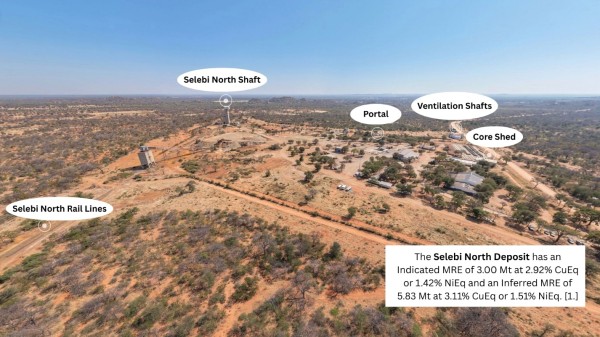
[1.] The MRE on the Selebi Mine is supported by the 2024 Technical Report. Reference should be made to the full text of the Technical Report for the assumptions, qualifications and limitations set forth therein, a copy of which is available on SEDAR+ ( www.sedarplus.com ) under NEXM’s issuer profile and on NEXM’s website here.
“These results are a critical confirmation point for Selebi North,” stated Morgan Lekstrom, CEO of NEXM, in the October 1, 2025 press release. “By bridging two major step-out holes and intersecting significant massive sulphide intervals, we have validated the down-plunge continuity and further strengthened our geological model. Once assays are received, these results will be incorporated into the updated MRE, reinforcing Selebi North’s scale, quality, and expansion potential.”
The Selebi North Mine is serviced by a 3.5-meter diameter shaft down to the 745-meter level and a twin 7° decline trucking ramp that currently descends to the 900-meter level.
The infrastructure and underground workings at Selebi North promote expedient and cost-efficient drill campaigns.
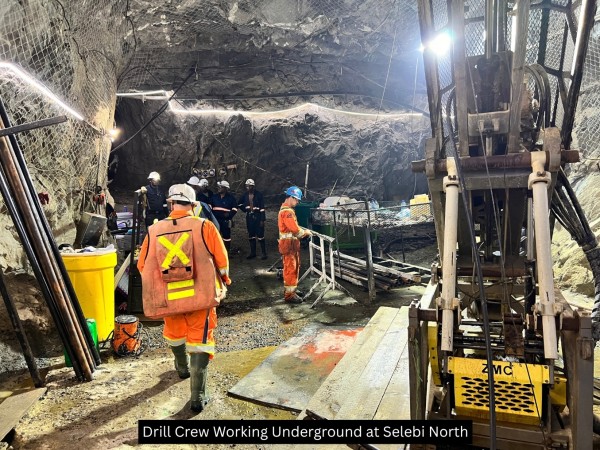
October 1, 2025 Drilling Highlights:
- SNUG-25-194 intersected 32.60 metres of continuous mineralization at Selebi North South Limb, including an aggregate total of 19.90 metres of massive sulphide across five sub-intervals.
- True thickness is estimated at 60 – 65%, which is consistent with geological interpretations of the South Limb.
- Drill hole SNUG-25-194 was designed to bridge mineralization between two widely spaced resource expansion drill holes SNUG-25-184, located 183 metres down-plunge from the current MRE, and SNUG-25-186, a further 130 metre step-out.
- The demonstrated continuity between these two major step-outs and results from additional strike step-outs from the resource expansion program can be incorporated into a future MRE update, supporting a potential expansion of the resource envelope.
- Borehole electromagnetic (BHEM) surveys are planned to characterize the conductive trends associated with the newly intersected massive sulphides to confirm continuity and outline strike extent.
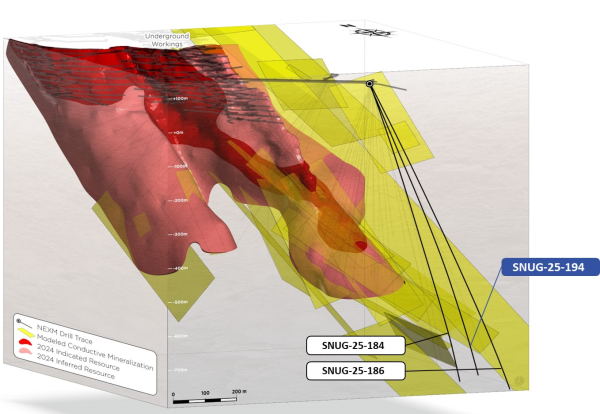
Above: Location of drill holes relative to the MRE and underground infrastructure.
The October 1, 2025 news follows an aggressive six-month development program at Selebi North.
April 10, 2025 – High Impact Six-Month Strategy Includes Deep Drilling at Selebi
April 17, 2025 – Infill Drilling at Selebi North Delivers 27.55 Metres of 4.97% CuEq
May 1, 2025 – Significant Mineralized Step-Out at Selebi North
May 27, 2025 – Extends Mineralization 315 Metres Below Resource Area
June 3, 2025 – “Hinge” Drilling Targets Large BHEM Plates between Selebi Deposits
June 30, 2025 – NexMetals Drills 13.50 Metres of 3.68% CuEq
July 28, 2025 – Initial 15.2% Head Grade Increase at Selebi North
August 13, 2025 – 16.25 Metres of 3.06% CuEq at Selebi North
August 21, 2025 – 19.40 Metres of 3.93% CuEq at Selebi North
September 3, 2025 – Metallurgical Breakthrough at Selebi Mines
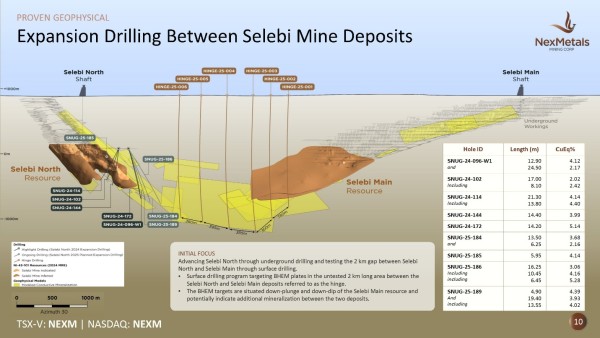
Concurrent with the development work at the Selebi Mine Deposits, NEXM has been focused on de-risking the Selkirk Mine, a past-producing copper-nickel-cobalt-platinum group elements (Cu-Ni-Co-PGE) mine situated 28 kilometers southeast of the city of Francistown (pop. 103,000), and 75 kilometers north of NexMetals’ Selebi Mines.
On October 7, 2025, NexMetals Mining released assay results from four additional holes in the 12-hole metallurgical drilling program at the Selkirk Mine in Botswana.
The 12-hole drill program wrapped up in August, focused on collecting samples for metallurgical testing, validating legacy data and adding key data points to support a future resource model update.
SMET-25-005 returned a wide interval of continuous mineralization: 219.00 metres of 1.03% CuEq (0.39% Cu, 0.33% Ni, 0.61 ppm Pd, 0.14 ppm Pt).
Mineralization outside the Mineral Resource Estimate (MRE) at Selkirk and within the current conceptual pit shell demonstrated the potential for expansion of the deposit toward the surface: SMET-25-005: starting at 47.00 metres from surface, 48.00 metres of 0.57% CuEq (0.19% Cu, 0.20% Ni, 0.34 ppm Pd, 0.08 ppm Pt).
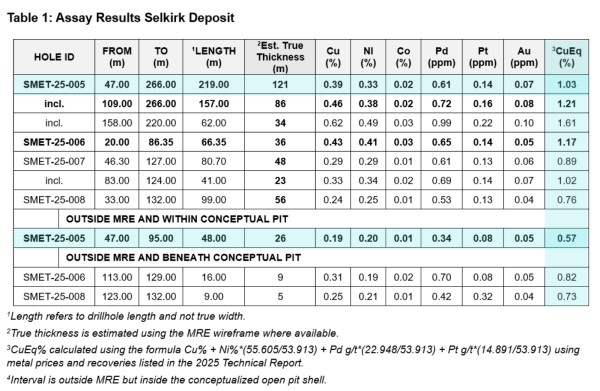
For the last decade, diamonds have accounted for around 80% of Botswana’s exports, one-third of fiscal revenues, and one-quarter of GDP. Botswana is the world’s largest diamond producer by value.
“The market for natural diamonds is in crisis, with cut-price lab-grown equivalents hitting demand particularly hard in the U.S.,” confirms Japan Times (JT) on September 4, 2025.
Botswana President Duma Boko has been vocal about his intention to diversify into non-diamond commodities. On September 26, 2025 the President appeared on CNN to discuss job creation, value-added in-country processing and expansion of intra-African trade.
“We want to strategically control the diamond sector and reform it as we go forward,” said President Boko on CNN. “But also diversify within the mining sector. In Botswana, we have other minerals which we haven’t exploited.”
“Copper production provides the most immediate source of economic diversification,” notes Lyle Begbie, an economist at Oxford Economics Africa.
“I’ve had the privilege of meeting President Duma Boko,” NexMetals CEO Lekstrom told GSN. “He is a Harvard Law School graduate, a passionate politician and a sharp businessman. We believe the Selebi and Selkirk copper-nickel projects can play a positive role in Botswana’s next economic evolution.”
The 32.6-meter intersection reported on October 1, 2025 represents the thickest interval of mineralization drilled by NEXM in its 2025 Selebi resource expansion program and will be included in the future updated Mineral Resource Estimate (MRE).
Assays are pending for SNUG-25-194 and an additional two holes, which are expected to further demonstrate the scale, continuity, and expansion potential of the Selebi North deposit.
[1]The mineral resource estimate on the Selebi Mine is supported by the technical report entitled “Technical Report, Selebi Mines, Central District, Republic of Botswana” and dated September 20, 2024. The report was prepared in accordance with NI 43-101 and Subpart 1300 of Regulation S-K and is available on SEDAR+ (www.sedarplus.ca) and EDGAR (www.sec.gov), in each case, under NEXM’s issuer profile.
All scientific and technical information in this news release has been reviewed and approved by Sharon Taylor, VP Exploration of the Company, MSc, P.Geo, and a “qualified person” for the purposes of National Instrument 43-101 and Subpart 1300 of Regulation S-K.
Contact: guy.bennett@globalstocksnews.com
Disclaimer: NexMetals Mining paid Global Stocks News (GSN) $1,750 for the research, writing and dissemination of this content.
Media Contact
Organization: Global Stocks News
Contact Person: guy.bennett@globalstocksnews.com
Website: https://www.globalstocksnews.com
Email: Send Email
Country:Canada
Release id:35123
The post NexMetals Step-Out Holes at Selebi North Validate Down-Plunge Continuity appeared first on King Newswire. This content is provided by a third-party source.. King Newswire makes no warranties or representations in connection with it. King Newswire is a press release distribution agency and does not endorse or verify the claims made in this release. If you have any complaints or copyright concerns related to this article, please contact the company listed in the ‘Media Contact’ section
About Author
Disclaimer: The views, suggestions, and opinions expressed here are the sole responsibility of the experts. No Digi Observer journalist was involved in the writing and production of this article.
-
Press Release6 days ago
DipCoin Dominates SuiFest 2025 as Platinum Sponsor: Crowded Booth, Nonstop Buzz, and Big Partnerships
-
Press Release5 days ago
Kazakhstan is the First in the Region to Introduce an AI-based Digital Board Member with Voting Rights
-
Press Release1 week ago
SproutGigs Unveils Rapid Social Media Growth Services Delivering Explosive Follower and Engagement Gains for Businesses Worldwide
-
Press Release6 days ago
VirPoint.com Unveils 2023 Financial Results and Launches AI Trading Suite at London Investor Summit
-
Press Release1 day ago
DLMSPV LLC and Michael Hartnett Helping Global Investors Identify Quality Assets through DSLAI and DLMSPVAI Frameworks
-
Press Release3 days ago
No Compromise on Quality or Design: Lonsdale Metals Glazing Bars Bring Tradition Innovation and Versatility to Modern Architecture
-
Press Release2 days ago
Nathan Smith Cayman and Rockwater Capital Announce Anticipated Completion of Point West Development
-
Press Release5 days ago
SmartTOP Convertible Top Control for BMW Z4 and Mini Now Permanently Reduced in Price



